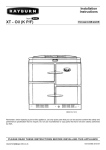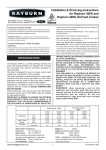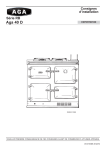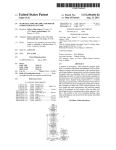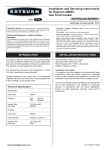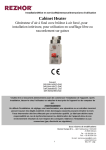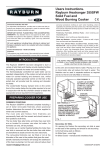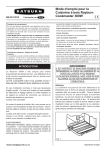Download Rayburn XT- Oil Specifications
Transcript
Servicing Instructions XT - Oil (K/PF) For use in GB and IE DESN 514112 B Remember, when replacing a part on this appliance, use only spare parts that you can be assured conform the safety and performance specification that we require. Do not use reconditioned or copy parts that have not been clearly authorised by AGA. PLEASE READ THESE INSTRUCTIONS BEFORE SERVICING THIS APPLIANCE [email protected] 10/13 EINS 514138 Contents SECTION CONTENTS PAGE CONSUMER PROTECTION HEALTH & SAFETY 3 3 INTRODUCTION SERVICE SCHEDULE 4 4 OIL BURNER REMOVAL PREPARATION BURNER ACCESS BURNER REMOVAL 5 5 6 CLEANING BURNER CHAMBER OVEN & HOTPLATE FLUEWAY CLEANING 7 7 OIL BURNER SERVICING BURNER NOZZLE REMOVAL IGNITION ELECTRODE PHOTO ELECTRIC CELL (PEC) CLEANING FAN CLEANING OIL LINE FILTER CLEANING FLEXIBLE OIL LINES 8 8 9 9 - 10 10 10 RE-COMMISSIONING - OIL BLEED AIR FROM OIL SUPPLY FIT PRESSURE PAUGE SWITCH ON ELECTRICITY VENT OIL PUMP ADJUST OIL PRESSURE SET COMBUSTION AIR CHECK SMOKE 11 11 11 11 11 12 12 FAN TERMINAL (CLEANING) TERMINAL COVER REMOVAL FAN REMOVAL FLUE TERMINAL REMOVAL 13 13 13 ELECTRICAL CONTROLS OVERHEAT SAFETY THERMOSTAT FLUE SAFETY DEVICE REMOVAL OF PCB POWER FLUE CONTROL PCB CONNECTIONS 14 14 14 14 15 REPLACEMENT OF PARTS (BURNER) FAN MOTOR PUMP ACCESS PUMP FILTER REPLACEMENT SOLENOID COIL IGNITION TRANSFORMER IGNITION ELECTRODES CONTROL BOX PEC 16 16 16 17 17 17 18 18 REPLACEMENT OF PARTS (ELECTRICAL CONTROLS) ELECTRICAL COMPONENT ACCESS PCB REPLACEMENT FAN REPLACEMENT TO FIT NEW FLUE SAFETY DEVICE TO FIT NEW OVERHEAT THERMOSTAT TO FIT NEW OVEN CONTROL THERMOSTAT TO FIT NEW TIMER RE-ASSEMBLE ELECTRICAL ASSEMBLY 19 19 19 20 21 21 21 21 ELECTRICAL CONTROLS WIRING DIAGRAM - APPLIANCE WIRING DIAGRAM - BURNER ONLY FAULT-FINDING BURNER HIGH SMOKE NUMBERS & OIL SMELLS FAULT FINDING CHART - GENERAL 400K P/F FAULT FINDING CHART - BURNER FAULT FINDING CHART - CONTROLS 22 23 24 25 26 27 28 - 29 2 Consumer Protection As responsible manufacturers we take care to make sure that are products are designed and constructed to meet the required safety standards when properly installed and used. IMPORTANT NOTICE: PLEASE READ THE ACCOMPANYING WARRANTY Any alteration that is not approved by AGA could invalidate the approval of the appliance, operation of the warranty and could affect your statutory rights. Health & Safety This appliance may contain some of the materials that are indicated It is the Users/Installers responsibility to ensure that the necessary personal protective clothing is worn when handling where applicable, the pertinent parts that contain any of the listed materials that could be interpreted as being injurious to health and safety, see below for information. Firebricks, Fuel beds, Artificial Fuels When handling use disposable gloves. Fire cement When handling use disposable gloves. Glues and Sealants Exercise caution - if these are still in liquid form use face mask and disposable gloves. Glass Yarn, Mineral Wool, Insulation Pads, Ceramic Fibre May be harmful if inhaled. May be irritating to skin, eyes, nose and throat. When handling avoid contact with skin or eyes. Use disposable gloves, face-masks and eye protection. After handling wash hands and other exposed parts. When disposing of the product, reduce dust with water spray, ensure that parts are securely wrapped. Kerosene & Gas Oil fuels (mineral oils) 1. The effect of mineral oils on the skin vary according to the duration of exposure. 2. The lighter fractions also remove the protective grease normally present on the surface of the skin. This renders the skin dry, liable to crack and more prone to damage caused by cuts and abrasions. 3. ‘Oil acne’ is recognised by the presence of skin rashes. The arms are most often affected, but may occur where there is contact with oil or oily clothing. - Seek medical attention for any rash. - Avoid skin contact with mineral oil or clothing contaminated with mineral oil. 4. Inhalation of mineral oil vapours must be avoided. Never fire the burner in the open as unburnt oil vapours are likely to occur. 5. Use a suitable barrier cream which will give protection against mineral oil, lanolin based hand creams are usually very effective. 6. Never syphon mineral oils by use of the mouth. If accidentally swallowed, call a doctor, do not induce vomiting. 3 INTRODUCTION SERVICE SCHEDULE To ensure the best performance from your Rayburn it should be serviced once a year. Annual Service BURNER REMOVAL - for cleaning and inspection. CLEANING - Heat exchanger flueways, oven and hotplate flueways together with ceramic fibre burner chambers. BURNER SERVICING. OIL PUMP SERVICING - Cleaning of fuel line strainer. RE-COMMISSIONING. REPLACEMENT PARTS. This appliance must be commissioned by a competent engineer, such as OFTEC approved. Failure to install and maintain appliances correctly could lead to prosecution. An additional flueway and combustion chamber clean halfway through the season may be necessary in some cases. NOTE: The external extractor fan should be regarded as a consumable part and replaced every 2 years. The Rayburn cannot be serviced whilst hot, so the thermostat should be turned off on the evening before the service visit. Oven Door Fit - Both doors must be checked and adjusted if necessary to ensure the alignment with the door catch is correct, the keep is secure and the oven is sealed when the door is closed. IMPORTANT: FLEXIBLE OIL LINE MUST BE RENEWED AT EACH SERVICE ON A 12 MONTHLY BASIS. 4 Oil Burner Removal PREPARATION WARNING: BEFORE REMOVING SERVICE ACCESS COVERS OR THE OIL BURNER ENSURE THAT ALL ELECTRICAL SUPPLIES TO THE APPLIANCE HAVE BEEN ISOLATED. The burner can be removed without disconnecting the oil supply pipe. However if the filter is being cleaned or a pressure gauge fitted to the pump then the oil supply should be turned OFF and arrangements made to catch any oil which will leak from the oil pump. BURNER ACCESS SEE FIG. 1 1. Open up the bottom burner access door. 2. Remove the 4 inner panel securing screws and remove panel. 3. Remove the 3 plinth securing screws and remove plinth. FIG. 1 5 DESN 514110 B Oil Burner Removal BURNER REMOVAL IMPORTANT: DURING BURNER REMOVAL CARE MUST BE TAKEN NOT TO DAMAGE THE CERAMIC FIBRE INSULATION. SEE FIG. 2 1. Place a sheet on the floor in front of the cooker to act as a working area 2. Disconnect the terminal strip plug. FIG. 2 DESN 511431 A BURNER LOCKING BOLTS SEE FIG. 3 3. Loosen the burner locking nuts (2). 4. Twist the burner. FIG. 3 DESN 511432 A FIG. 4 DESN 511433 B SEE FIG. 4 5. Withdraw the burner unit. 6 Cleaning BURNER CHAMBER IMPORTANT: DURING CLEANING CARE MUST BE TAKEN NOT TO DAMAGE THE CERAMIC FIBRE INSULATION. SEE FIG. 5 & 5A 1. TO REMOVE THE HOTPLATE: Remove the bolt and washers from inside the Roasting Oven (top left hand side) Lift insulating covers and remove 2 screws from the hotplate, then remove hotplate using lifting tool provided. 2. Clean the flueway by inserting the flexible brush through top plate aperture, directing it towards the flue outlet. Scrape the deposits towards the burner chamber. 3. Thoroughly clean burner chamber flueway 4. Carefully vacuum any debris that has fallen down into the burner chamber. FIG. 5 DESN 514184 FIG. 5A DESN 514113 OVEN & HOTPLATE FLUEWAY CLEANING SEE FIG. 5A, 5 & 6 1. Open the top oven door. 2. Remove side and base access doors using hex. driver. 3. Thoroughly clean, top side and base flueways through access apertures with brush. 4. Remove all debris with vacuum cleaner. 5. Replace side and base access doors. Secure in position using hex. driver. 6. Brush and clean in between hotplate ribs on underside. 7. Examine soft rope seal located around hotplate aperture in top plate. Replace if frayed or damaged. 8. Replace hotplate ensuring the underside ribs lie over the oven. NOTE: Ensure that the hotplate is fitted correctly as this forms part of the cooker combustion circuit. FIG. 6 7 DESN 514118 A Oil Burner Servicing BURNER NOZZLE REMOVAL SLACKEN (2) HEX. SCREWS SEE FIG. 7 CHANGE THE NOZZLE AT THE ANNUAL SERVICE. 1. Remove blast tube by slackening two hex. screws. Thoroughly clean the blast tube. 2. Remove (2) screws securing access door. 3. Slacken (2) screws on either side of access door. 4. Open access door. 5. Remove push on electrode leads. 6. Slacken screws securing electrodes. 7. Pull out electrodes. 8. Using socket spanner unscrew nozzle. Ensuring hexagon is held, to stop nozzle holder turning. 9. Remove nozzle and check filter for debris. Replace with one of same specified make and pattern 10. Refit nozzle taking care not to overtighten. 11. Re-assemble in reverse order. DESN 511436 A NOTE: Do not touch the face of nozzle to avoid blocking of fine drilling. IGNITION ELECTRODE SEE FIG. 7 and PAGE 15. Inspect the ignition electrodes for crazing in the porcelain. Replace if there are any signs of deterioration. DESN 511437 FIG. 7 8 DESN 510238 Oil Burner Servicing PHOTO ELECTRIC CELL (PEC) CLEANING SEE FIG. 8 Withdraw Photo Electric Cell from the burner head. Clean PEC sensing end with a soft cloth taking care not to scratch the light sensitive body. Re-insert the PEC taking care to insert the correct way round. IF BADLY DISCOLOURED CHANGE IT. FIG. 8 DESN 511438 FAN CLEANING SEE FIG. 9 INSPECT AND CLEAN IF NECESSARY. 1. Remove (2) screws securing terminal strip/ transformer bracket. 2. Remove (2) push on electrode leads from transformer. DESN 511439 FIG. 9 9 DESN 511440 Oil Burner Servicing SEE FIG. 10 3. Remove (3) screws securing fan motor onto burner body. 4. Withdraw assembly from burner body. 5. Clean impeller with a soft brush. 6. Spin motor to check that it turns easily. FIG. 10 DESN 511441 FIG. 11 DESN 511442 SEE FIG. 11 7. Remove (1) screw and slacken (2) screws from air slider control. 8. Remove air slider and clean any fluff deposits. 9. Re-assemble in reverse order ensuring that earth terminal is secured behind the screw onto the terminal/transformer bracket. OIL LINE FILTER CLEANING 1. Turn OFF the line isolating valve fitted prior to the oil line filter. 2. Dismantle filter by unscrewing bolt at base of bowl. 3. Make arrangements to catch kerosene. 4. Wash filter thoroughly in clean kerosene. 5. Re-assemble filter in reverse order of removal. FLEXIBLE OIL LINES REMEMBER Do not kink hoses. Do not pass hoses through side casing panels. Always flush oil through before final connection. Check hose for signs of discolouration, cracking or oil seepage. Replace if necessary. 10 Re-commissioning - Oil BLEED AIR FROM OIL SUPPLY Disconnect the flexible oil pipe at the pump inlet, open the stop valve slowly and run off some of the oil into a receptacle to establish an air free supply to the pump. Remake the connection oil tight and leave valve open. FIT PRESSURE GAUGE SEE FIG. 12 Remove the bleed screw from the manifold and fit an oil pressure gauge with R1/8 connection to check the pump output pressure. SWITCH ON ELECTRICITY Set the thermostat to maximum. The burner should run on pre-purge for 7 to 15 seconds, with the ignition spark energised. The oil solenoid valve should open allowing the burner to fire. Until all the air from the oil pump is flushed out there may be some flame instability resulting in the burner locking out. This will be shown by the burner stopping and the illumination of the signal light in the reset button of the control box (see Fig. 13). IN THIS EVENT, WAIT AT LEAST ONE MINUTE, then press the re-set button to restart. FIG. 12 DESN 511427 FIG. 13 DESN 511428 VENT OIL PUMP SEE FIG. 12 Whilst the burner is running, vent air from the pump by slackening the pressure gauge port sufficient to allow air to bleed out. When bubble free oil seeps out re-tighten. ADJUST OIL PRESSURE SEE FIG. 12 With the burner running check the oil pressure on the pressure gauge. If the pressure gauge is not indicating the correct reading then adjust the pressure by turning the pressure regulator clockwise to increase or anti-clockwise to decrease the pressure until the pressure gauge reads 7.6 bar (110 lb/in2). 11 Re-commissioning - Oil SET COMBUSTION AIR SEE FIG. 14 After 15 minutes of the burner running. To sample the flue gases from the cooker burner lift up the R.H. insulating cover and remove the countersunk headed screw and insert the sensing end of a portable analyser to check the CO2 (Carbon Dioxide) level in the hotplate. The cooker burner should be set to 11.0% CO2. IMPORTANT: Ensure that the bottom louvered plinth is in place during combustion setting procedures and the outer door is closed. CHECK SMOKE Remove the CO2 sampling tube and using the same hole for flue sampling insert the sensing end of a Baccarach Smoke Pump and check that the smoke in the flue ways does not exceed 0-1 on the scale. DESN 511429 A Replace the countersunk headed screw on completion ensuring that it will not interfere with any pots and pans placed on the hotplate. FIG. 14 12 DESN 514111 Fan Terminal (Cleaning) TERMINAL COVER REMOVAL 1. Disconnect power to appliance. 2. The terminal cover is secured using 4 screws. Unscrew the 4 screws and remove cover. (See Fig. 15). FIG. 15 DESN 513351 FIG. 16 DESN 513355 FIG. 16A DESN 513354 FAN REMOVAL 1. Disconnect the power to appliance. 2. Disconnect the 3 wires to the fan. 3. Unscrew (3) M5 fixings and withdraw, fan and mount assembly. 4. Clean fan with a soft brush. 5. Re-fit fan and mount assembly. FLUE TERMINAL REMOVAL In order to gain access to the flue for cleaning it is necessary to remove the flue terminal assembly. 1. Disconnect the power to the appliance. 2. Unscrew (4) M5 fixings that connect the flue pipe to the terminal backplate. 3. Disconnect 3 wires from terminal strip (cooker supply side). 4. Remove cable restraint clamp and free cable. 5. Unscrew (4) wall fixings and withdraw backplate assembly. 6. Clean flue pipe as required. 7. Inspect flue terminal gasket and replace if necessary. 8. Re-assemble in reverse order. 13 Electrical Controls OVERHEAT SAFETY THERMOSTAT IMPORTANT NOTE: This appliance is fitted with an overheat thermostat which has a manual reset button. If the overheat stat trips, the cooker will not operate, until the button has been pushed-in (reset). The engineer needs to follow ‘Fault Finding Guide’ to establish why the stat tripped. (The overheat thermostat and its sensing phial are located on the controls chassis rear). (See Fig. 25). FLUE SAFETY DEVICE This thermostat is a safety cut-out device which will operate under adverse wind or a blocked flue condition. It is a manually reset device which can be reset by pressing in the centre. FIG. 17 DESN 514123 B FIG. 18 DESN 512570 FIG. 19 DESN 512562 REMOVAL OF PCB SEE FIG. 18 1. Remove plinth (3 screws). 2. Unscrew two fixing screws just in front of PCB. 3. Lift the PCB slightly and slide forward. POWER FLUE CONTROL SEE FIG. 19 1. Check the control voltage to the fan. 2. Turn the appliance on. Between + and - the voltage will be 24V dc. 3. Between - and signal the voltage should read approximately 4.0V dc initially, then drop to 2.6V dc after 30 seconds. 4. The fan should also slow down. 14 Electrical Controls PCB CONNECTIONS FIG. 20 15 Replacement of parts (Oil Burner) FAN MOTOR SEE FIG. 21 Follow instructions in sections BURNER ACCESS, Steps 1 to 3, FAN CLEANING, Steps 1 to 4 and BURNER REMOVAL, Steps 1 to 5. 1. 2. 3. 4. Disconnect wires from terminal strip. Slacken (3) grub screws securing pump to fan body. Remove pump. Fit new fan motor and assemble in reverse order ensuring pump coupling is correctly located. FIG. 21 DESN 511447 FIG. 22 DESN 511448 PUMP ACCESS SEE FIG. 21 Follow instructions in section BURNER ACCESS, Steps 1 to 3 and BURNER REMOVAL, Steps 1 to 5. 1. 2. 3. 4. 5. 6. 7. 8. Isolate fuel supply. Disconnect flexible hose. Disconnect pump outlet supply tube. Remove solenoid securing nut. Remove solenoid. Slacken (3) grub screws on pump flange. Remove pump. When re-fitting pump, inspect pump coupling for signs of wear or cracking, replace if necessary and ensure it is correctly positioned before tightening grub screws. 9. Re-assemble in reverse order. PUMP FILTER REPLACEMENT SEE FIG. 22 1. Remove (4) pump plate securing screws and remove plate. 2. Remove filter. 3. Fit new filter. 4. Re-assemble in reverse order. 16 Replacement of parts (Oil Burner) SOLENOID COIL SEE FIG. 21 Follow instructions in sections BURNER ACCESS, Steps 1 to 3 and BURNER REMOVAL, Steps 1 to 5. 1. 2. 3. 4. Remove solenoid plug securing nut. Pull off electrical connection socket from solenoid. Remove solenoid coil. Fit new solenoid coil, re-assemble in reverse order. IGNITION TRANSFORMER Follow instructions in sections BURNER ACCESS, Steps 1 to 3. 1. 2. 3. 4. 5. Remove (4) screws securing transformer. Remove both H.T. leads from transformer. Disconnect the wires from the terminal strip. Remove transformer. Fit new transformer, re-assemble in reverse order. IGNITION ELECTRODES SEE FIG. 7 Follow instructions in sections BURNER ACCESS, Steps 1 to 3, BURNER REMOVAL, Steps 1 to 5 and BURNER NOZZLE REMOVAL, Steps 2 to 7. 1. Remove ignition electrode assembly. 2. Fit new ignition electrode assembly, in reverse order of removal. 3. Check electrode gap and rest if necessary. 17 Replacement of parts (Oil Burner) CONTROL BOX SEE FIG. 23 Follow instructions in sections ‘BURNER ACCESS’, Steps 1 to 3. 1. Insert flat bladed screwdriver in LH side of c.box, as diagram. 2. Repeat as above for RH side. 3. Gently pull control box away from mounting plate. 4. Fit new control box, re-assemble in reverse order. FIG. 23 PEC SEE FIG. 8 Follow instructions in sections BURNER ACCESS, Steps 1 to 3, BURNER REMOVAL, Steps 1 to 5. 1. 2. 3. 4. 5. 6. Unplug PEC. Undo wire connections from terminal strip. Withdraw PEC cable. Slacken and remove PEC clip (note orientation of clip). Transfer and secure clip to new PEC. Fit new PEC, re-assemble in reverse order. 18 DESN 511249 Replacement of parts (Electrical controls) ELECTRICAL COMPONENT ACCESS BEFORE REMOVING SERVICE ACCESS COVERS ENSURE THAT ALL ELECTRICAL SUPPLIES TO THE APPLIANCE HAVE BEEN TURNED OFF. SEE FIG. 24 1. Open the controls door. 2. Remove thermostat control knob. 3. Remove 2 cover panel securing screws and remove cover panel. 4. Remove the four control panel fixing screws. 5. Tilt the chassis forwards from the top and lift out. To fully access the rear of the control chassis, the oven thermostat capillary should be removed from the oven. Follow instructions in section ‘TO FIT NEW OVEN CONTROL’ thermostat, Steps 3 to 6. FIG. 24 PCB REPLACEMENT SWITCH OFF POWER TO THE APPLIANCE. 1. See Page 11 for removal of PCB. 2. Disconnect all the wires. 3. Fit wires to new PCB (wiring on Page 22). FAN REPLACEMENT SWITCH OFF POWER TO THE APPLIANCE. 1. Access and Removal, see Page 12. 19 DESN 514121 Replacement of parts (Electrical controls) FIG. 25 DESN 516745 TO FIT NEW FLUE SAFETY DEVICE ENSURE THAT ALL ELECTRICAL SUPPLIES TO THE APPLIANCE HAVE BEEN TURNED OFF. SEE FIG. 26 Follow instructions in section BURNER ACCESS, Steps 1 to 3. 1. 2. 3. 4. 5. 6. Remove PCB. Unscrew flue safety device. Remove bracket and unclip phial. Disconnect the two wires on the switch. Unscrew nut holding the stat body and remove. Replace in reverse order of removal. FIG. 26 20 DESN 512569 Replacement of parts (Electrical controls) TO FIT NEW OVERHEAT THERMOSTAT SEE FIG. 25 Follow instructions in section COMPONENT ACCESS, Steps 1 to 5. ELECTRICAL 1. Undo the locknut, which holds the overheat thermostat to the bracket on the rear of the chassis. 2. Remove the 2 push on connectors from back of overheat thermostat. 3. Remove the phial from the 2 spring clips on the rear of the chassis. 4. Withdraw overheat thermostat from chassis. 5. Fit replacement overheat thermostat and assemble in reverse order. COOKER THERMOSTAT TO FIT NEW OVEN CONTROL THERMOSTAT THERMOSTAT PHIAL LOCATION SEE FIG. 27 Follow instructions in section COMPONENT ACCESS, Steps 1 to 5. DESN 511738 C ELECTRICAL 1. Undo the two screws on the front of the chassis which holds the thermostat in place. 2. Remove the (2) push on connectors from back of thermostat. 3. Open roasting oven door and using a screwdriver, loosen the rear fixing screws and remove the front fixing screw of the inner L.H. oven side to expose the thermostat stat phial. 4. Slacken the single screw where the phial passes through the roasting oven side and rotate the cover plate to open the access hole. 5. Slacken the single screw on the phial securing bracket and rotate the cover bracket. 6. Withdraw the capillary and phial from the oven. 7. Fit replacement thermostat and assemble in reverse order. ORANGE FIG. 27 RE-ASSEMBLE To complete, follow instructions in ‘RE-ASSEMBLE’, Steps 1 to 5. 1. Locate the base of the control chassis into the bottom of the doorway aperture, tilt the chassis backwards into position and secure with the (4) screws. 2. Thread the wires for the cooker timer through the aperture and connect them onto the rear of the cooker timer fitted in the outer panel. 3. Refix the outer panel in position and secure with the (2) screws. 4. Replace the thermostat knob. 5. Replace the controls door. TO FIT NEW TIMER Follow instructions in section COMPONENT ACCESS’ Steps 1 to 4. DESN 510546 ‘ELECTRICAL 1. Remove timer by depressing retaining clips. To complete follow instructions in section ‘REASSEMBLE’, Steps 2 to 5. 21 Fault Finding WIRING DIAGRAM - APPLIANCE FIG. 28 22 Fault Finding WIRING DIAGRAM - BURNER ONLY FIG. 29 23 Fault Finding Burner Check that the burner has not gone to lockout. Causes of lockout can be:l l l l l l l l No ignition, ignition electrode incorrectly positioned or insulation cracked, spark generator faulty, check for 230V at spark generator. No oil supply. Poor combustion. Photo electric cell incorrectly positioned, cracked or needs cleaning. Live and Neutral connections reversed. Oil valves not properly closed in shutdown position. Faulty control box. Faulty fire valve. General For access to individual controls refer to section on Replacement Parts and for wiring continuity checks refer to schematic wiring layouts. To check out the electrical wiring at the burner you will first have to have access to the burner chamber. Use the following procedure:1. 2. 3. 4. Isolate the electrical power supply. Open up the bottom burner access door. Remove door and put in a safe place. Unscrew the 4 screws holding the inner panel in place and remove panel. Unscrew the 3 screws holding the louvered plinth in place and remove plinth. The external mains connections are made to the controller in the front right hand corner of the cooker under the oven. Re-connect the electrical supply and check that there is 230V power supply available across the mains input connections L & N on the controller. If not then check connecting leads, fuse and whether power is available at mains plug. If power is available across L & N check the appliance. 24 Fault Finding HIGH SMOKE NUMBERS NOZZLE FAULT REPLACE NOZZLE AIR INTAKE BLOCKED CHECK AIR INLET TO BURNER INCORRECT COMBUSTION SETTINGS RE-ADJUST TO INSTALLATION INSTRUCTIONS OIL PRESSURE INCORRECT ADJUST TO RECOMMENDED SETTINGS INCORRECT COMPONENTS USED ON COMBUSTION HEAD SEE SERVICING INSTRUCTIONS INTERNAL BURNER CHAMBER INSULATION PANELS INCORRECTLY POSITIONED OR FAULTY OIL SMELLS FUMES ON START UP DOWN DRAUGHT CHECK WITH GAUGE OIL SOAKED HEARTH NUMEROUS LOCK-OUTS ODOURS IN KITCHEN BURNER FAULT CURE THE LOCK-OUT CONDITION 25 OIL LEAKS AT PIPE FITTINGS TAKE APART AND REMAKE AS REQUIRED LEAKS AT TUBING CONNECTORS ENSURE END OF TUBING SQUARE Fault Finding IMPORTANT NOTE: REFER TO OVERHEAT THERMOSTAT’, PAGE 14. 26 Fault Finding 27 Fault Finding 28 Fault Finding 29 30 31 For further advice or information contact your local distributor/stockist With AGA Rangemaster’s policy of continuous product improvement, the Company reserves the right to change specifications and make modifications to the appliance described at any time. Manufactured by AGA Rangemaster Station Road Ketley Telford Shropshire TF1 5AQ England www.rayburn-web.co.uk www.agacookshop.co.uk 32
































